What is the potoo bird? Where do they live? What do they eat? What’s up with their kooky eyes? Is this what’s going through your head? Then you are in the right place! Stay tuned for all you want to know about potoos.
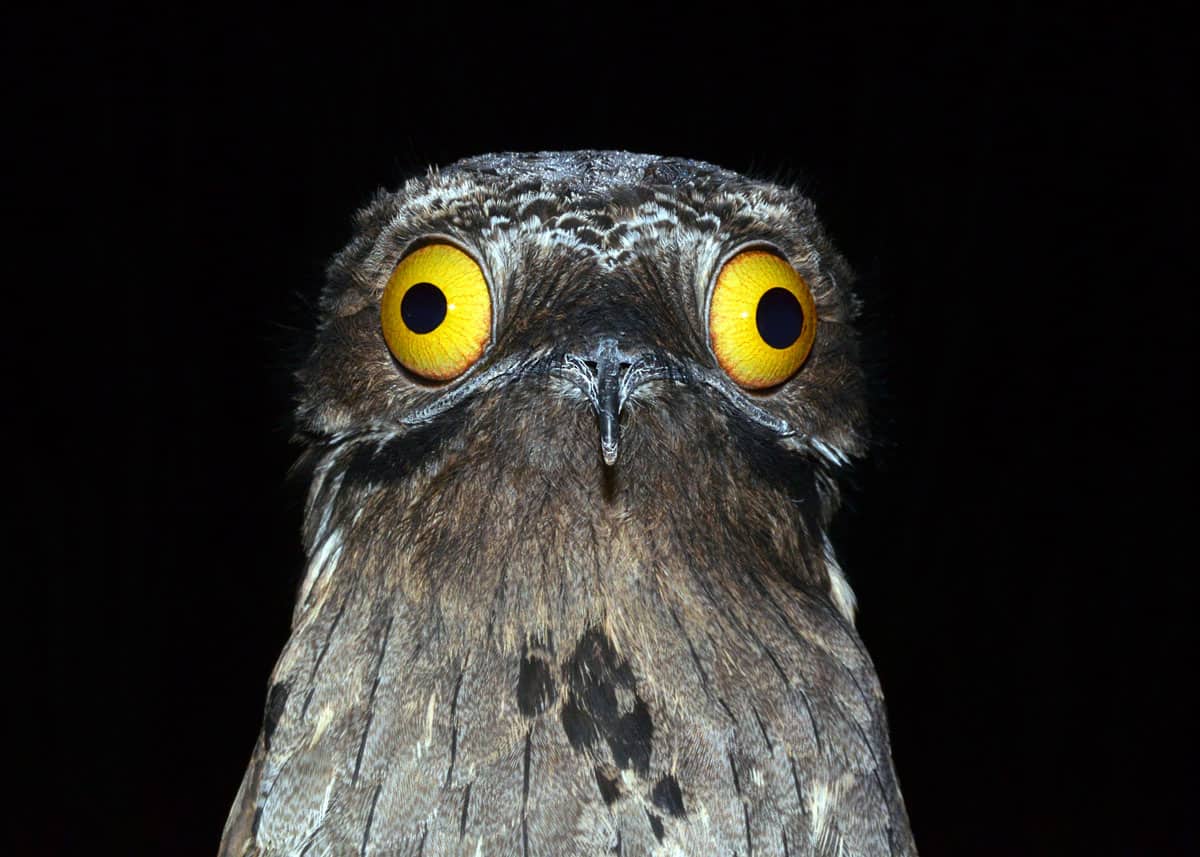
Potoos are some of the most fascinating birds on the planet. You might think that’s an exaggeration, but it’s true.
They’ve mystified ornithologists for years because of their elusive, secretive habits, and they’ve captured the imagination of everyday people who use them for memes and viral videos.
Let me take you on a journey of fun potoo facts.
Table of Contents
Ultimate Guide to the 7 Potoo Species
The first thing to know about potoo birds is that they come in seven different species. While they have the same general features and behaviors, they can differ in both subtle and not-so-subtle ways.
Take a look and see for yourself.
1. Rufous Potoo
- Latin name: Nyctibius bracteatus
- Where they are found: Ecuador, Peru, Brazil, Guyana, Colombia, French Guiana
- Size: 8 – 10 inches (height), 46 – 58 grams (weight)
- Diet: Butterflies, beetles, locusts, grasshoppers, crickets
- Conservation status: Least concern
The smallest of their species, rufous potoos are named after their reddish-brown coloring. “Rufous” refers to the color of rust or oxidized iron.
Rufous potoos were a mystery to birdwatchers until the late 20th century. They were rarely spotted in the wild, and no one had any idea what they sounded like or where they made their nests.
There was a watershed moment when everyone realized that the rufous potoos had been under their noses the entire time. They were just that good at camouflage!
Their rusty coloring hid them among the leaves and branches of their favorite trees, and their white spots looked like the fungus that sometimes grows on plants.
Rufous potoos will even rock back and forth to make themselves look like leaves fluttering in the breeze. If that isn’t dedication to a disguise, nothing is.
2. Great Potoo
- Latin name: Nyctibius grandis
- Where they are found: Central and South America (from southern Mexico to southeastern Brazil)
- Size: 18 – 23 inches (length), 360 – 650 grams (weight), 27 – 33 inches (wingspan)
- Diet: Beetles, katydids, bats
- Conservation status: Least concern
The opposite of the tiny rufous potoo is the great potoo. They’re the largest of their species, and they have an impressive wingspan that can stretch almost twice as long as their bodies.
The easiest way to distinguish a great potoo from its brothers is its size. However, you can also look at differences in coloring.
While other potoos might come in exclusive shades of brown or red, great potoos can be white, gray, brown, beige, burgundy or mottled with a mixture of colors.
Another notable thing about the great potoo is its eyes. If you’ve ever seen memes with large, yellow-eyed potoos gazing into infinity with enormous pupils, that was probably a great potoo.
Great potoos are one of the best-researched branches of the potoo family, so we have a lot of information on their feeding, breeding and nesting habits. They make for very interesting reading if you’re in the mood for potoo facts!
3. Long-Tailed Potoo
- Latin name: Nyctibius aethereus
- Where they are found: Western Amazon Basin (Brazil, Bolivia, Venezuela, Ecuador, Peru, Paraguay, Colombia)
- Size: 18 – 20 inches (length), 280 – 447 grams (weight)
- Diet: Moths, butterflies, beetles, flying termites
- Conservation status: Least concern
The long-tailed potoo is another shy bird that doesn’t like to be observed by humans. For a long time, no one knew its exact range; they just made assumptions based on its proximity to other members of the species.
Things became clearer when it was determined that there were several sub-species of the long-tailed potoo, including nyctibius aethereus aethereus, nyctibius aethereus chocoensis, and nyctibius aethereus longicaudatus.
All three of these sub-species have their own range across South America, but they look the same and have the same diets, habitats, and behaviors. They’re just scattered across the continent in different groups.
As its name suggests, the long-tailed potoo has an immensely long collection of tail feathers. They’re usually brown with black bands that stretch in horizontal lines across their full plumage.
4. White-Winged Potoo
- Latin name: Nyctibius leucopterus
- Where they are found: Brazil, Guyana, Peru, French Guiana
- Size: 9 – 11 inches (length); 77 – 85 grams (weight)
- Diet: Unknown, but probably insects
- Conservation status: Least concern
White-winged potoos are small brown birds with distinctive white patches on their feathers. They have the crazy yellow eyes that make their species such a popular meme, and they look even crazier than most since they’re rarely photographed in the daylight.
Most pictures of the white-winged potoo show a small, jittery bird with lunatic eyes that shine like headlights in the dark.
Once you get past their appearance, however, the white-winged potoo is an intriguing mystery. Not much is known about their particular breed, so every breadcrumb of information is another piece in the puzzle.
We can assume that the white-winged potoo has similar hunting and breeding habits to the rest of the species, but we can’t be certain.
For all we know, the white-winged potoo is out there with completely revolutionary bird behavior, and we won’t learn about it until someone takes the time to document them.
5. Andean Potoo
- Latin name: Nyctibius maculosus
- Where they are found: Andes mountains (Venezuela, Peru, Colombia, Ecuador, Bolivia)
- Size: 13 – 15 inches (length), 145 – 195 grams (weight)
- Diet: Large insects like beetles and grasshoppers
- Conservation status: Least concern
The Andean potoo is the most mysterious of all the potoo species. Instead of covering a wide habitat, it’s only been documented in splotches of land across the Andes mountains.
Instead of observing its feeding habits in the wild, we can only guess at their diet based on the contents of their stomachs after they’ve died.
Where do they nest? How do they camouflage themselves from predators? Do they have any unique habits to their species? We just don’t know.
The only thing that we can be sure about is the physical appearance of the Andean potoo. It has a brown body with tufty, almost dirty-looking plumage in various shades of white, black, grey and tan.
If you ever see a bird like this while traveling through South America, make sure to whip out your camera. You might just snap a rare photo of a rare creature.
6. Common Potoo
- Latin name: Nyctibius griseus
- Where they are found: Central and South America (from northern Nicaragua to southern Uruguay)
- Size: 14 – 16 inches (length), 160 – 190 grams (weight), 33 – 37 inches (wingspan)
- Diet: Cicadas, moths, beetles, ants, grasshoppers, flying mantises
- Conservation status: Least concern
The common potoo has the widest distribution of any potoo. You can find it just about everywhere in Central and South America, including Argentina, Costa Rica, Panama, Brazil, Bolivia, Paraguay, and Uruguay.
Of course, actually locating the common potoo will be a challenge. It’s a master of camouflage, and it can blend into trees like it was painted there.
Some birds will even become motionless with tilted-up beaks so that they’ll look like jagged, broken-off branches.
In terms of appearance, it isn’t always distinguishable from other members of its kind. It might be a tad lighter with white and gray feathers dominating over darker ones, but this doesn’t apply to all common potoos.
There are also some variations between its two sub-species nyctibius griseus griseus and nyctibius griseus panamensis.
Despite its name, the common potoo isn’t all that common. It’s a fascinating creature, and many of our potoo facts come from the lives and habits of common potoos!
7. Northern Potoo
- Latin name: Nyctibius jamaicensis
- Where they are found: Mexico, Costa Rica, Jamaica, Hispaniola
- Size: 15 – 18 inches (length), 253 – 257 grams (weight)
- Diet: Moths, beetles, butterflies, crickets
- Conservation status: Least concern
The northern potoo is located more in Central America than South America. It has five distinct subspecies scattered across both the land and the water of the Caribbean islands: N. j. abbotti, N. j. jamaicensis, N. j. costaricensis, N. j. lambi and N. j. mexicanus.
The coloring of the northern potoo is usually dark and splotchy with various shades of brown, black, white and gray. It can be identified by a black stripe that runs over its throat in a lateral pattern.
Another way of picking the northern potoo out of a crowd is by listening closely to its call.
While all potoos are known for their eerie, mournful cries, the northern potoo’s is particularly elongated. It can go on for minutes at a time.
How’s that for an oceanside feeling?
30 Amazing Potoo Facts, Photos, and Videos
Now that you’ve gotten a quick overview of the species, let’s talk about potoos as a whole. You might not believe some of this crazy trivia, but I assure you, all of these mind-blowing facts are true.
1. Are potoo birds real?
You can be forgiven for wondering if the potoo bird is real. With so many manipulated images on the web, a bug-eyed bird with protruding pupils and a gaping maw might ping your “fake” radar.
However, potoos are very real. Not everything is known about them since they’re such hidden creatures, but ornithologists are learning more about their family tree every day, and it’s a lot of fun.
There are tons of interesting and quirky habits found in the potoo species. These are some seriously cool birds!
2. How many kinds of potoos are there?
In case you need a refresher, here are the seven species of potoo birds:
- Rufous potoo, a small, russet-colored bird
- Great potoo, the largest breed of the species
- Long-tailed potoo, a potoo known for its extra-long tail feathers
- White-winged potoo, a potoo known for its white wings
- Andean potoo, a mysterious bird that lives in the mountains
- Common potoo, the most diverse and well-populated potoo
- Northern potoo, a special type of potoo living further north than others
There are also several subspecies:
- The common potoo has two sub-species.
- The long-tailed potoo is spread across three different regions of South America, and each cluster has been classified as its own sub-species with its own scientific name.
- The northern potoo has two sub-species groups with even more sub-species under them. There are five in total.
3. Are potoos nocturnal?
Yes. Potoos rest during the day and come alive at night. This is why they have such luminescent eyes: they’re primed for night vision.
You can actually reflect headlights and flashlights off them when it’s dark outside.
4. Is the potoo an owl?
No, but this is a common question. Since potoos and owls are both nocturnal birds with similar habits and colors, it’s easy to mistake them for one another.
There are even owl species like otus balli that have big yellow meme eyes.
5. What are the differences between potoos and owls?
The most obvious difference between potoos and owls is the way they hunt. Owls stretch their legs and use their talons to catch, kill and carry their prey back to their roosts.
They might occasionally snatch something from mid-air, but they’ll also hunt for little critters scurrying across the ground.
Meanwhile, potoos almost always catch their prey in the air. In fact, most of their diet consists of flying insects like moths, butterflies, and winged beetles.
They’ll streak across the night with their beaks wide open like nets. They rarely pluck anything off the ground.
Another distinctive feature of owls is their facial discs. Potoos don’t have them, so if you’re wondering whether that bird outside of your window is a black-capped screech owl or a long-tailed potoo, look for the facial disc.
6. How did the potoo get its name?
While there aren’t any official records about this, it’s possible that the potoo got its name from the “po-TOO” cries of similar birds.
They’re commonly associated with nightjars, frogmouths, and boobooks.
7. Are potoos friendly?
The short answer is “no.” The long answer is “it depends.”
Potoos aren’t violent or aggressive birds, so you don’t have to worry about getting clawed if you venture too close to their nests. However, it would be a stretch to call them friendly.
They’re shy, secretive creatures that like to camouflage themselves in the trees, and when they sense a potential predator, their first instinct is to hide.
Even potoos in zoos and wildlife centers have to be handled with care.
While they can be trained to accept being fed or medicated by a human, they’re easily stressed by excessive amounts of handling, and they tend to keep to themselves whenever possible.
Long story short, potoos just aren’t the type of bird to rest on your finger and sing you a song.
8. Are potoos aggressive?
Potoos aren’t known to be aggressive. For example, instead of screeching when they’re panicked or afraid, they’ll shut down. They’ll try to blend into their surroundings and escape notice rather than engage with the danger.
There are two exceptions to this: great potoos and common potoos. Both species will exhibit mobbing behavior when they have sufficient numbers to take a stand.
Mobbing behavior is when birds surround a predator while making loud noises and ducking, swooping, chasing, and even attacking it.
Mobbing only works when potoos cooperate as a group, so it’s rare. Potoos are solitary by nature. However, it does happen.
9. How long do potoos live?
No one knows! It’s been suggested that they live around 12 – 14 years, but this is just an educated guess based on the lifespans of similar species.
There’s still so much that we don’t know about potoos.
10. What eats a potoo? Predators and Threats
As relatively small birds, potoos face many threats in the wild, including:
- Weasels
- Forest falcons
- Capuchin monkeys
- Spider monkeys
- Mantled howler monkeys
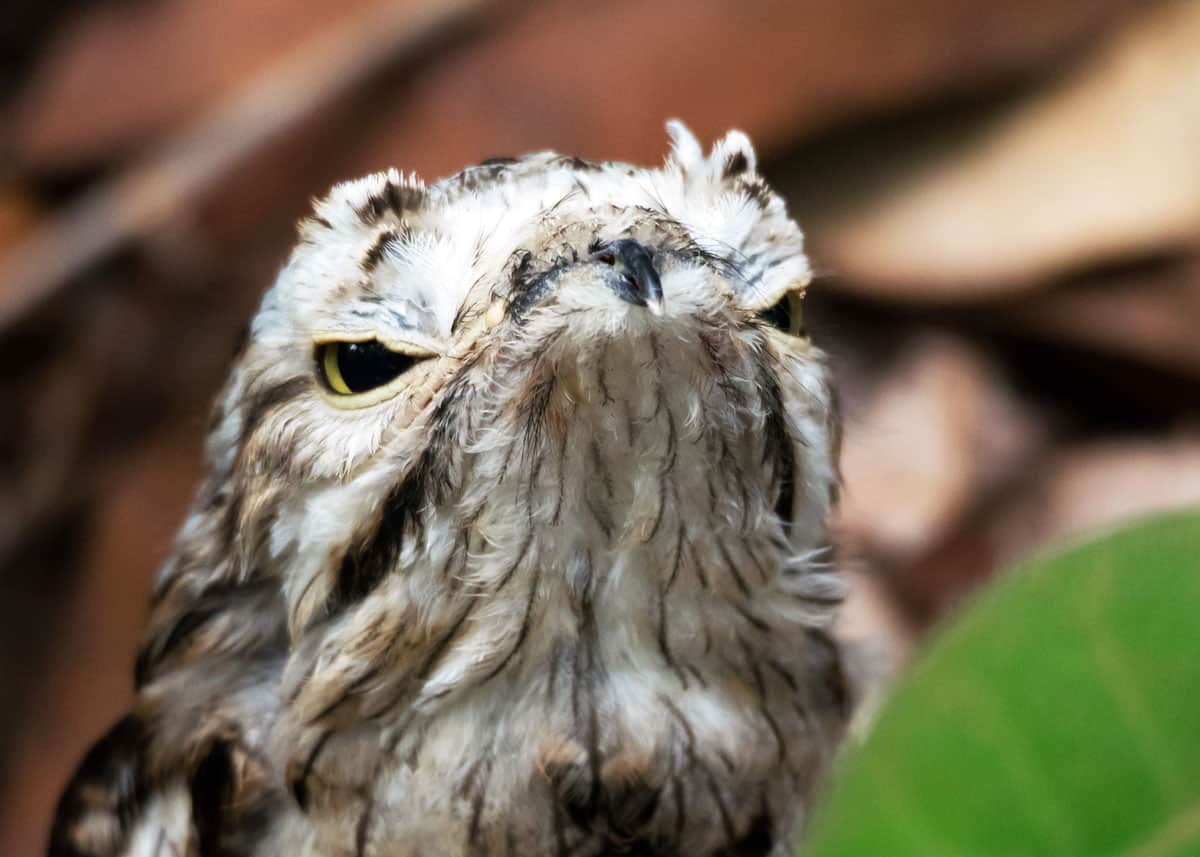
A baby potoo
In addition to the animals that will prey on them on adults, there are a number of creatures that will snatch them up as eggs or hatchlings.
Snakes are the most common egg thieves. They can swallow them whole.
11. Is the potoo bird endangered?
No. While there aren’t any exact figures for the number of potoos in the world, it’s clear that they aren’t endangered. They occupy wide-ranging habitats in many different countries.
It is believed that their general population might be on the decline, but it isn’t happening quickly enough to be a concern.
The International Union for the Conservation of Nature (IUCN) has ranked several potoo species as “least concern” on the extinction scale:
- Rufous potoo
- Great potoo
- Long-tailed potoo
- White-winged potoo
- Andean potoo
- Common potoo
BirdLife International has ranked the last species as “least concern” as well:
- Northern potoo
12. Can potoos see with their eyes closed?
It’s strange but true: Potoos have slits in their upper eyelids that help them see things even when their eyes are shut.
It isn’t known if they have full vision through the slits or if the slits just serve as a kind of general warning system for changes in lights and shadows.
13. What do potoos eat?
They might live in different regions, but all potoos share the same diet. They’re insectivores that like to munch on bugs.
As for the specific insects that potoos have been documented eating, the list looks a little something like this:
- Rufous potoo – Butterflies, beetles, locusts, grasshoppers, crickets
- Great potoo – Beetles, katydids, bats
- Long-tailed potoo – Moths, butterflies, beetles, flying termites
- White-winged potoo – Unknown
- Andean potoo – Large insects like beetles and grasshoppers
- Common potoo – Cicadas, moths, beetles, ants, grasshoppers, flying mantises
- Northern potoo – Moths, beetles, butterflies, crickets
Only great potoos and common potoos have been documented eating non-insects. They’ve gone after bats and small birds as well.
14. How long can potoos survive without eating?
There isn’t a ton of information on this, but it’s been observed that rufous potoos have extra fat around their abdominal cavities.
This might be storage for rainy or moonless nights when hunting is difficult, or it might sustain the birds when they’re incubating their eggs for long periods of time.
Either way, it’s proof that they’re biologically equipped to survive at least short periods without eating.
15. How do potoos hunt?
It’s pretty metal. Not only do potoo birds hunt in the dead of night, but they strike after being motionlessly concealed in the trees for hours on end. Their prey doesn’t even see them coming.
When the poor little butterfly looks up, however, the last thing that it sees is the wide-open beak of the potoo. They swoop down with their wings outstretched and their jaws gaping wide.
Death is usually instantaneous. Sometimes, the potoo will swallow its snack right then and there, but it usually takes the insect carcass back to the nest and consumes it there. This is especially practical when it’s a large kill like a bat.
16. What other names does the potoo have?
Each potoo species has its own scientific name. Some of them also have nicknames. Here’s a complete list, including origins and meanings:
- Rufous potoo (nyctibius bracteatus, from the Latin meaning “gold leaf”)
- Great potoo (nyctibius grandis, from the Latin meaning “big” or “large”)
- Long-tailed potoo (nyctibius aethereus)
- White-winged potoo (nyctibius leucopterus), also known as the white-feathered potoo
- Andean potoo (nyctibius maculosus, from the Latin meaning “speckled”)
- Common potoo (nyctibius griseus), also known as the lesser potoo and the gray potoo
- Northern potoo (nyctibius jamaicensis)
Their family name, nyctibius, is a Greek word that means “night-dwelling” or “night-living.”
Potoos, in general, are sometimes called “poor-me-ones” because of their haunting cries.
17. Do potoos mate for life?
It’s possible that potoos mate for life. They form monogamous pairs during mating season; it just isn’t known if these match-ups last for life.
A fun fact about potoos is that it’s extremely difficult to tell males and females apart because they look so similar.
You can imagine the pain when it comes to tracking specific birds or mated pairs over a long period of time.
18. How often do potoos lay eggs?
Most experts agree that potoo birds only lay one egg per year, but no one is 100 percent sure about this.
As for when that egg is laid, it depends on the mating season of the species.
- Great potoos – Great potoos usually breed between February – August, but rather than adhering to any calendar, they tend to mate during the rainy season of their particular country. For example, Colombian great potoos breed between March and April, and Venezuelan great potoos breed between June and August. Surinamen great potoos get busy in November. These periods all correspond to rainy seasons.
- Long-tailed potoos – Long-tailed potoos reproduce between July – November. Unlike great potoos, their cycles usually coincide with the end of the dry season.
- Common potoos – The northern sub-species has a mating season between April – July. The southern sub-species breed between November – December.
- Northern potoos – These potoos breed in the first half of the year. In Jamaica, the mating season is between February – May; in Hispaniola, it’s between April – July.
- Andean potoos, white-winged potoos, rufous potoos – We don’t know anything about their breeding seasons.
19. How many eggs do the potoo lay? What do they look like?
Potoo birds lay one egg at a time, and since they only reproduce once per year, everything rides on that one little egg. Its appearance will vary depending on the species:
- Great potoo – white with gray, brown or purple spotting
- Long-tailed potoo – white
- Common potoo – white with brown and red-brown flecks
- Northern potoo – white streaked with black, brown and lilac
- Andean potoos, white-winged potoos, rufous potoos – unknown
Incubation takes around 30 days for all species. Both parents will safeguard their egg and tend to it after it hatches.
This child-rearing includes everything from regurgitating food directly into their beaks to monitoring their first flights from the nest.
20. What are baby potoos like?
Hatchlings are small and covered in fuzz. They’ll start to grow feathers after about two weeks, and they’ll be ready to leave the nest in a month or so.
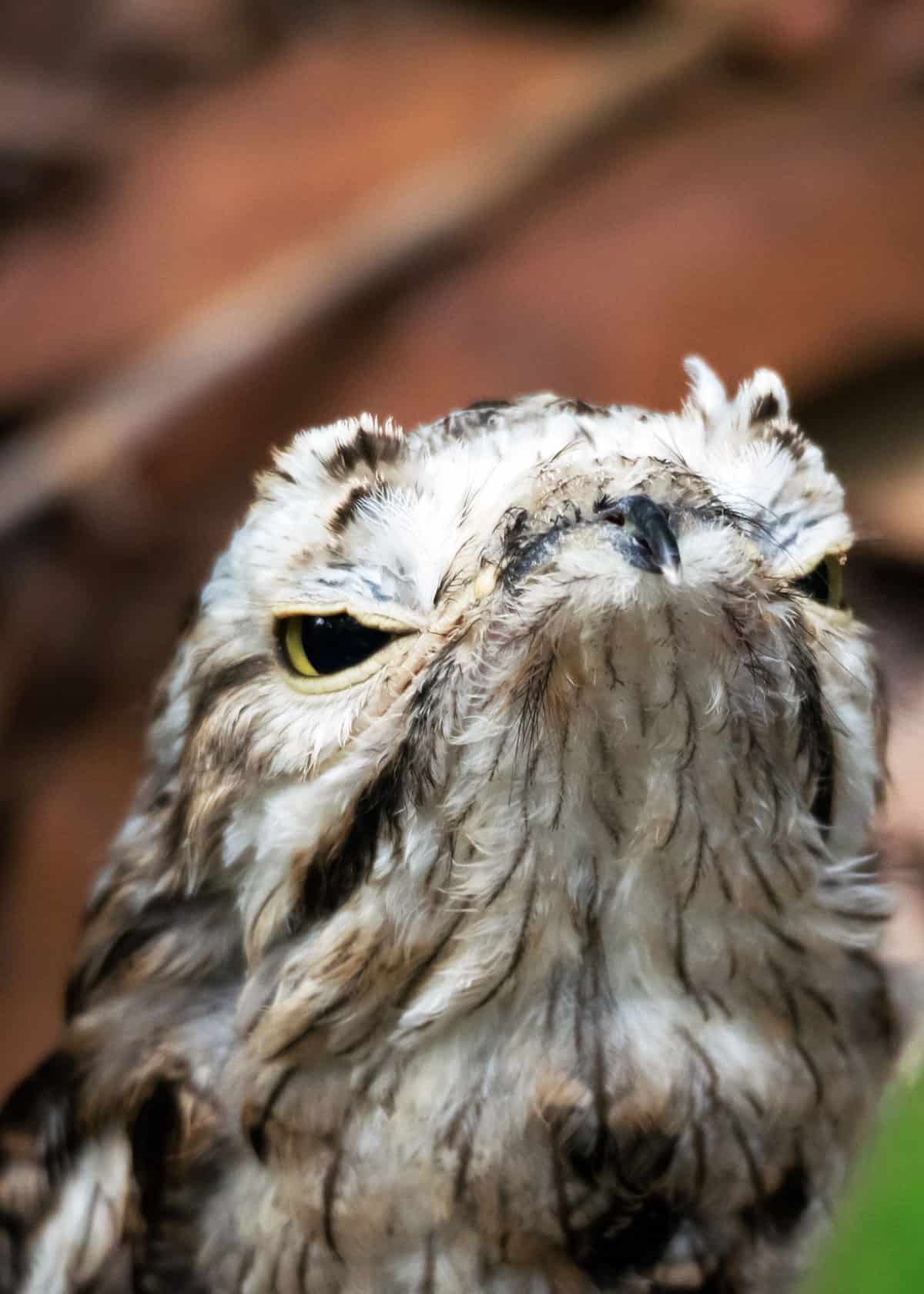
A potoo chick
However, they won’t separate from mom and dad right away; they’ll stick around and learn important things about hunting, flying, grooming, vocalizing and hiding from predators. They won’t be truly independent until 2 – 2.5 months.
21. What is the potoo’s call?
Potoos are known for their eerie nighttime calls. It’s often said that they sound like human moans, groans, and wails, and there are many superstitions about what might befall a person who hears them.
What do they actually sound like? It depends on what species has your ear:
- Rufous potoo – Rufous potoos make “boo-boo-boo” calls that slowly descend in pitch, so they’re a lot like common potoos. However, they don’t warble their tunes every night. Rufous potoos only sing during the week of the full moon. It might sound like another superstition, but it’s true!
- Great potoo – Great potoos have two distinct calls. The first is a “wop” or “whoap” that brings to mind a human moan; the second is a throaty “bao” that has been characterized as everything from a groaning teenager to a mournful widow.
- Long-tailed potoos – Long-tailed potoos have a very plaintive cry. It’s a soft, lengthy “waa-OO-uh” that trembles in the air.
- White-winged potoo – These birds are a bit more high-pitched than their brothers. They vocalize with “hweep” and “weuuuu” noises that are more like whistles than moans. Since they usually fire off these sounds in a rapid-fire way, it can sound almost like chirping.
- Common potoos – These birds have an eight-series call with descending notes that fade in pitch and volume as they trail off. It goes from “BU-OH” to “BU-oh” to “bu-oh.”
- Andean potoo – The call of the Andean potoo is a “raa-aa” or “aah-aa” sound. They also have a descending call with three “ah-ah-ah” notes before mating.
- Northern potoo – The sounds of the northern potoo have been described as “kwaaaa-kwa,” “bwaahhhr ah-ah” and “wahhrrr wah-wah.” It’s generally agreed that the first sounds are the most elongated while the secondary sounds are short, repeat calls.
22. Are potoos loud?
Yes. They might not shriek or scream like other birds, but you can definitely hear potoos when they get going.
It’s one of the reasons why potoos have a reputation for creepiness on long, lonely nights; their mournful cries can be heard throughout the dark forests that they inhabit, so nearby villages get spooked.
23. Where does the potoo live?
The range of the potoo depends on its particular species. Here’s a breakdown:
Rufous potoo. Rufous potoos are found in Ecuador, Peru, Brazil, Guyana, Colombia, and French Guiana. Despite this laundry list of countries, however, they only occupy small regions in western South America. They just so happen to cross a lot of borders.
Great potoo. Great potoos have a wide and diverse range that stretches across both Central and South America. Starting in Mexico and trailing all the way down to Brazil, their native countries include Panama, Peru, Guyana, Venezuela an, Suriname.
Long-tailed potoo. The long-tailed potoo has three sub-species that occupy three distinct regions of South America:
- Nyctibius aethereus chocoensis is only found in western Colombia. It’s a small bundle of birds without a lot of range.
- Nyctibius aethereus aethereus is the most widespread species. They’re all over the Amazon rainforest, spreading as far as Venezuela in the north and Bolivia in the south.
- Nyctibius aethereus longicaudatus is found around the Atlantic Forest region. This is a stretch of land along the Atlantic coast that includes northern Brazil and eastern Argentina. These birds have been recorded at altitudes of almost 4,000 feet.
White-winged potoo. Another species that sticks to a relatively small region, white-winged potoos are found in a V-shaped distribution across Brazil, Guyana, and Peru. There’s also an isolated community in French Guiana.
Andean potoo. Andean potoos are found in the Andes. This includes Venezuela, Peru, Colombia, Ecuador, and Bolivia.
Common potoo. The common potoo has the widest range of any potoo species. They occupy almost the entire top half of South America, and they have tendrils creeping into Central America as well. They’re found in Mexico, Argentina, Panama, Brazil, Bolivia, Paraguay, and Uruguay.
Northern potoo. Northern potoos are located in Central America rather than South America. They’re most common in Mexico, Costa Rica and the two Caribbean islands of Jamaica and Hispaniola. They also have two sub-species groups:
- Nyctibius aethereus abbotti and nyctibius aethereus jamaicensis are in the group nyctibius jamaicensis. As you might expect from their names, these are the birds inhabiting Jamaica and Hispaniola. They have excellent flight capabilities that allow them to spread across the islands.
- Nyctibius aethereus costaricensis, nyctibius aethereus lambi and nyctibius aethereus mexicanus are in the nyctibius aethereus mexicanus group. They’re the birds in Mexico and Costa Rica.
24. What is the habitat of the potoo?
All potoos live and nest in trees, but they can be picky about the particular types of trees that they inhabit. Not only does it affect their camouflaging capabilities, but it has a big impact on their diet as well.
- Rufous potoo – For some reason, the rufous potoo seems to prefer trees that are rooted in nutrient-poor soil. No one is quite sure why, but it might have something to do with the weakness of their tiny statures or the availability of local insects.
- Great potoo – Great potoos live in a wide variety of grasslands, lowlands, forests, and foothills. They’ve even been spotted in meadows and forest clearings. As long as there are trees nearby, great potoos can survive just about anywhere.
- Long-tailed potoo – Most long-tailed potoos live in the Amazon rainforest and the Atlantic Forest, so they like tropical locations with lots of biodiversity.
- White-winged potoo – White-winged potoos don’t mind getting a little wet. They’re most commonly observed in hot, humid rainforests, and they also congregate around streams and the edges of rivers. They’ve been recorded at altitudes of almost 3,000 feet.
- Andean potoo – As residents of the Andes, these birds like mountainous regions with lots of tree cover. They’re found at elevations of 6,000 – 9,000 feet. It’s thought that they can handle colder climates better than their brothers since they live in higher altitudes.
- Common potoo – Since they occupy such a broad range of land, common potoos have been found in everything from humid rainforests to dry savannas. However, they tend to avoid mountain ranges. They rarely fly more than 6,000 feet.
- Northern potoo – Northern potoos are at home in both wet and dry forests. They’ll also settle into mangroves, thickets and even residential towns. They’ve been known to stalk street lamps for the bugs that buzz around them.
25. Can potoo species co-exist in the same environment?
Yes. The long-tailed potoo has been tracked and tagged among several other potoo species, including the common potoo. Northern potoos and common potoos have been known to share habitats in Costa Rica.
Incidentally, this is another one of the reasons why it can be so difficult for ornithologists to gather data on potoo birds.
When they look the same, hunt the same and occupy the same regions, it’s tough for researchers to tell the difference between them. The northern potoo was even considered a sub-species of the common potoo until it was discovered that they had different calls.
26. How do potoos camouflage?
All potoo birds engage in some sort of camouflage. However, they accomplish this task in different ways:
- Rufous potoos – These small brown birds rock themselves back and forth to imitate dead leaves fluttering in the wind. They have white patches on their feathers that look like tree fungus, so their disguise is perfect.
- Great potoos, common potoos, northern potoos – These species become motionless when confronted with danger. They’ll completely freeze and try to blend into the bark of a tree by not moving a muscle. They might also crane their necks and raise their beaks until they look like jutting branches with sharp points.
- Andean potoos, white-winged potoos, long-tailed potoos – Not enough is known about these particular species to make a guess about their camouflaging habits. They might freeze; they might shake. They might even do something completely different. It’s a mystery!
27. Can you eat a potoo?
Potoos aren’t really hunted for their meat.
It isn’t taboo, so a hungry village might make an attempt, but potoos are so small and difficult to locate in the foliage that it isn’t really worth the energy that it takes to hunt them.
28. Do potoos have any significance in South American culture?
There are a lot of stories and superstitions about potoos. For example, it’s considered bad luck to mock them even though they have such a wild-eyed appearance.
The cry of the potoo is also seen as an ill omen; it’s associated with things like death, doom, and tragic lovers.
The rural people of Ecuador have an elaborate myth about a woman turning into a potoo after losing her husband: it’s said that she cries for him every night, and that’s why the potoo sounds so heartbroken.
On the flip side, there are a few places where potoos are seen as useful or valuable creatures. In Brazil, they’re considered symbols of chastity, so they’re used in ceremonies and rituals to strengthen people against seduction.
Some people also kill and stuff them as unique prizes.
29. Where do potoos nest?
Potoos don’t make true nests. They don’t gather twigs and reeds to create bedding spaces for their eggs. Instead, they’ll deposit their eggs in specific places:
- Rufous potoos – Rufous potoos nest in broken tree stubs that are a few inches wide. They lay their eggs with extreme accuracy right on top of the stub.
- Great potoos – This species likes to nest high in the trees. They find a crevice or jutting branch that’s around 30 feet high and claim it as their own.
- Common potoos, long-tailed potoos, northern potoos – These birds lay their eggs in the hollows of tree trunks or the depressions of branches.
- Andean potoos, white-winged potoos – No one knows how these birds nest.
30. Where can I see the potoo?
Potoos can be found in zoos, parks, wildlife centers and bird sanctuaries all around the world.
They’re rarer in places like Europe and Asia compared to their native South America, but you can still find captivity-raised potoos in places where guests are allowed to look at animals.
Potoo Memes – A Brief History
Unless you’ve been living under a rock, you’ve probably seen a few potoo memes. Their bulging yellow eyes make for great reaction pics. But do you know where these goofy images originated?
It started in 2013 on a Reddit forum called /r/funny. Someone posted an image gallery filled with potoos, and it garnered a lot of amusement and disbelief.
A few months later, another user turned a potoo picture into a meme called “Weird Stuff I Do Potoo,” and that’s when things really went worldwide. People started confessing their strange habits and idiosyncrasies by printing them over a picture of a startled potoo.
||
|
Today, potoos have become a go-to source for strange faces and shocked reaction images.
They’re mostly harmless, but try not to let silly memes distract you from the truth about potoos. They’re complex creatures living lives that we don’t fully understand!
Memes are still lots of fun though… make your own potoo meme here!
How Do You Do, Potoo?
If you’ve made it this far, you’ve probably gained a new understanding of potoo birds. Your next task is to spread the word.
Whenever someone on social media posts a goofy picture of potoos, link them to this article so that they can learn real-life potoo facts!
Drew Haines is an animal enthusiast and travel writer. She loves to share her passion through her writing.
She graduated high school at sixteen and started her own business, Everywhere Wild Media. And she runs Everywhere Wild and JustBirding. She also guest blogs on Storyteller.Travel
She lived in Ecuador for 6 years and explored the Galapagos Islands. Currently based in N.S., Canada.

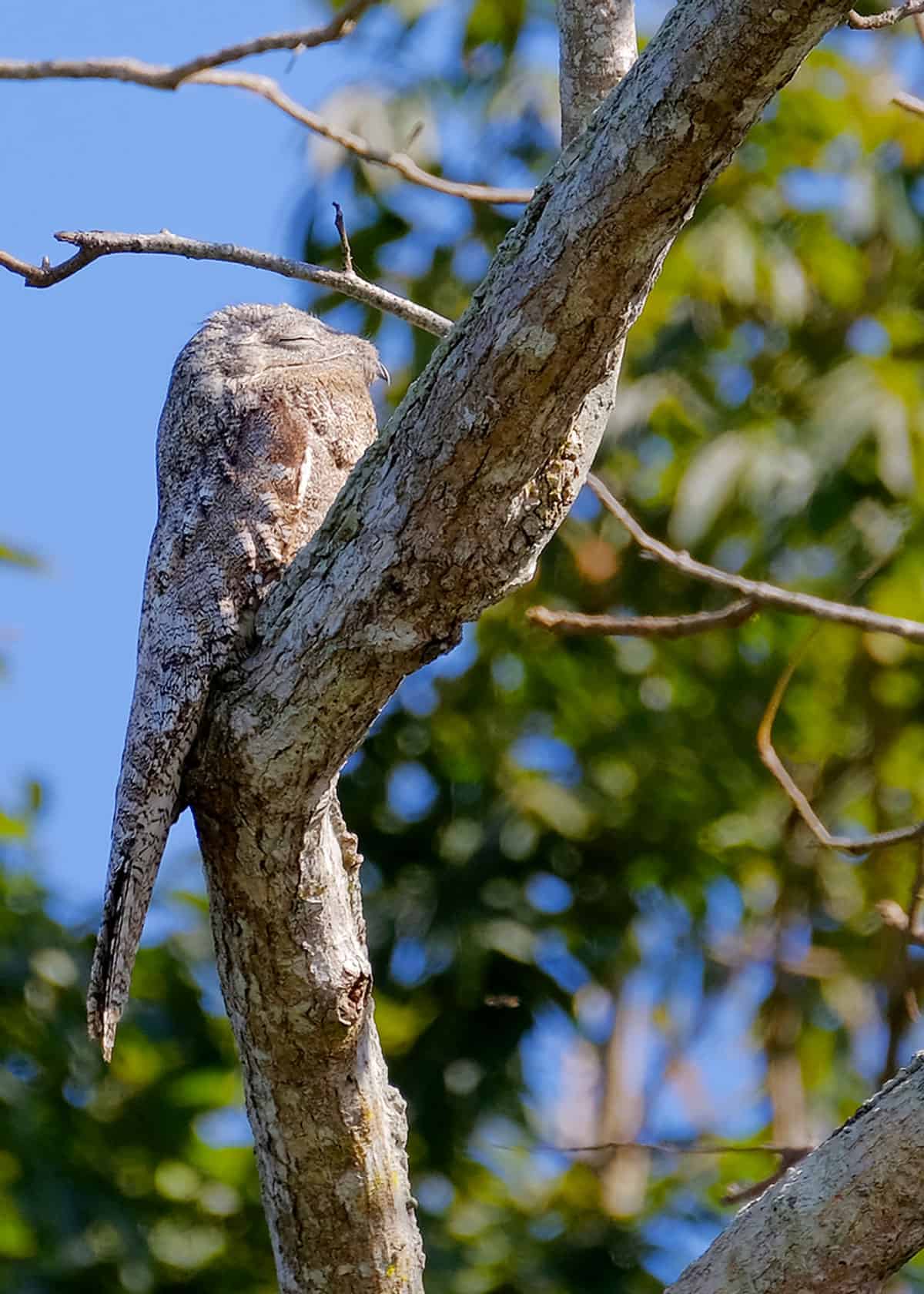
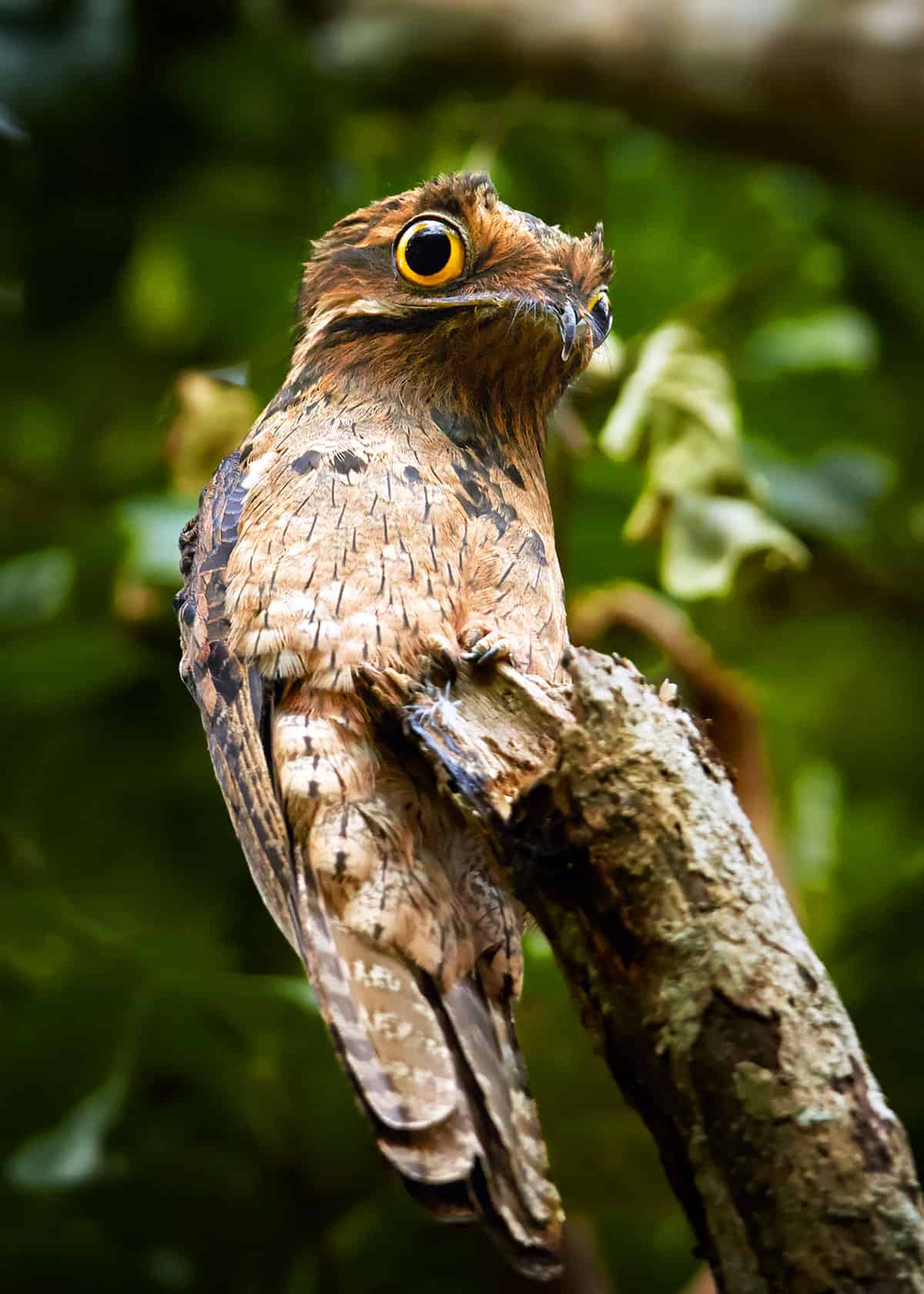
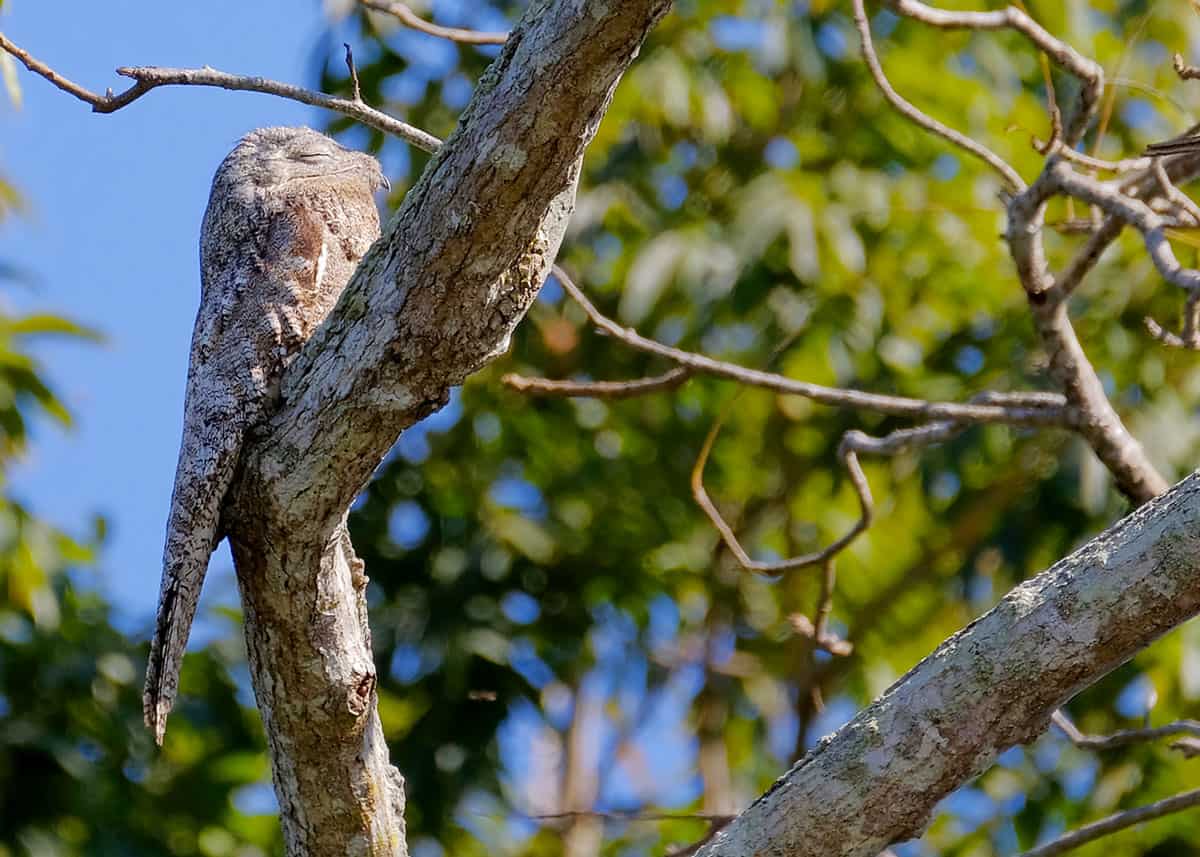
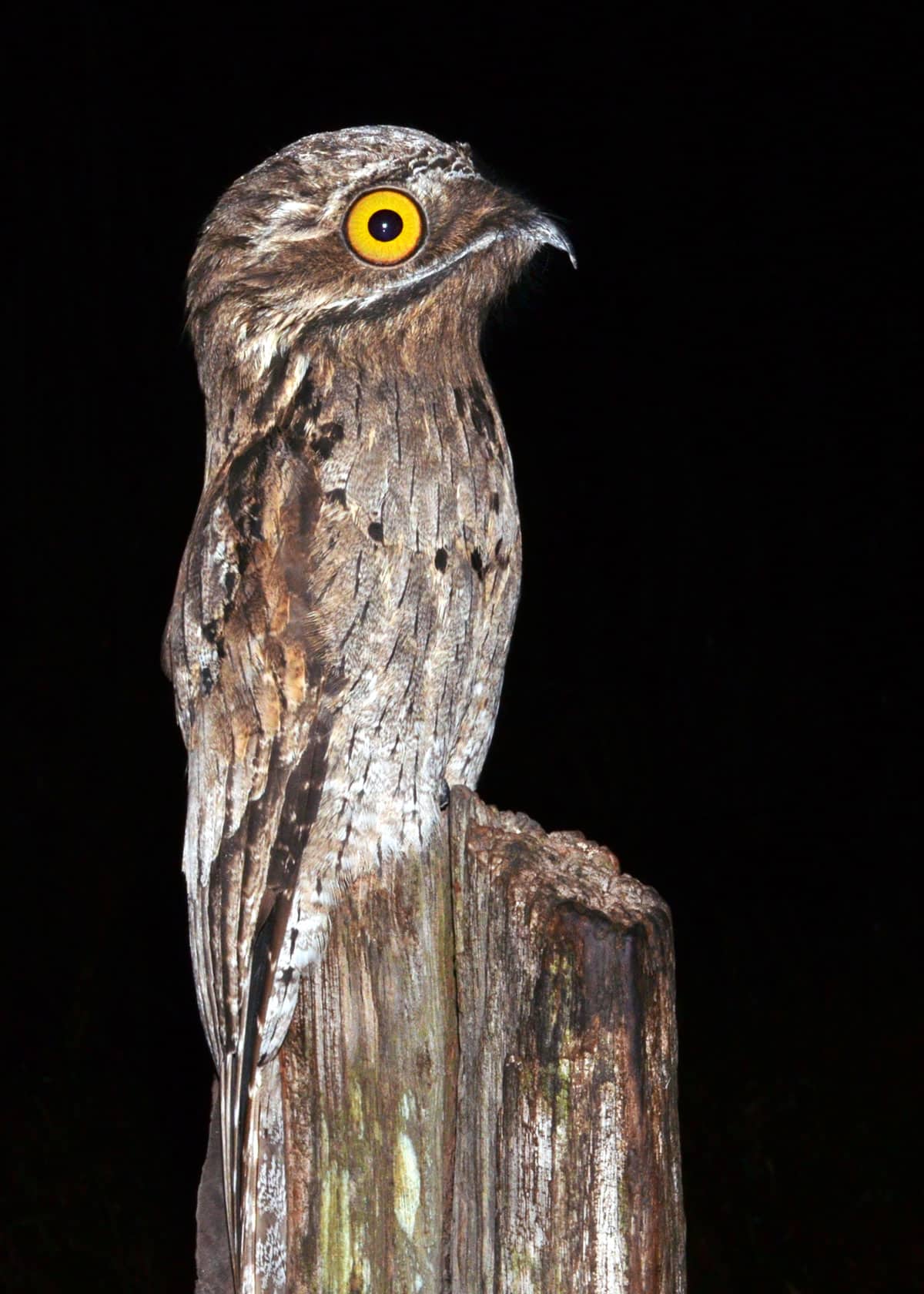
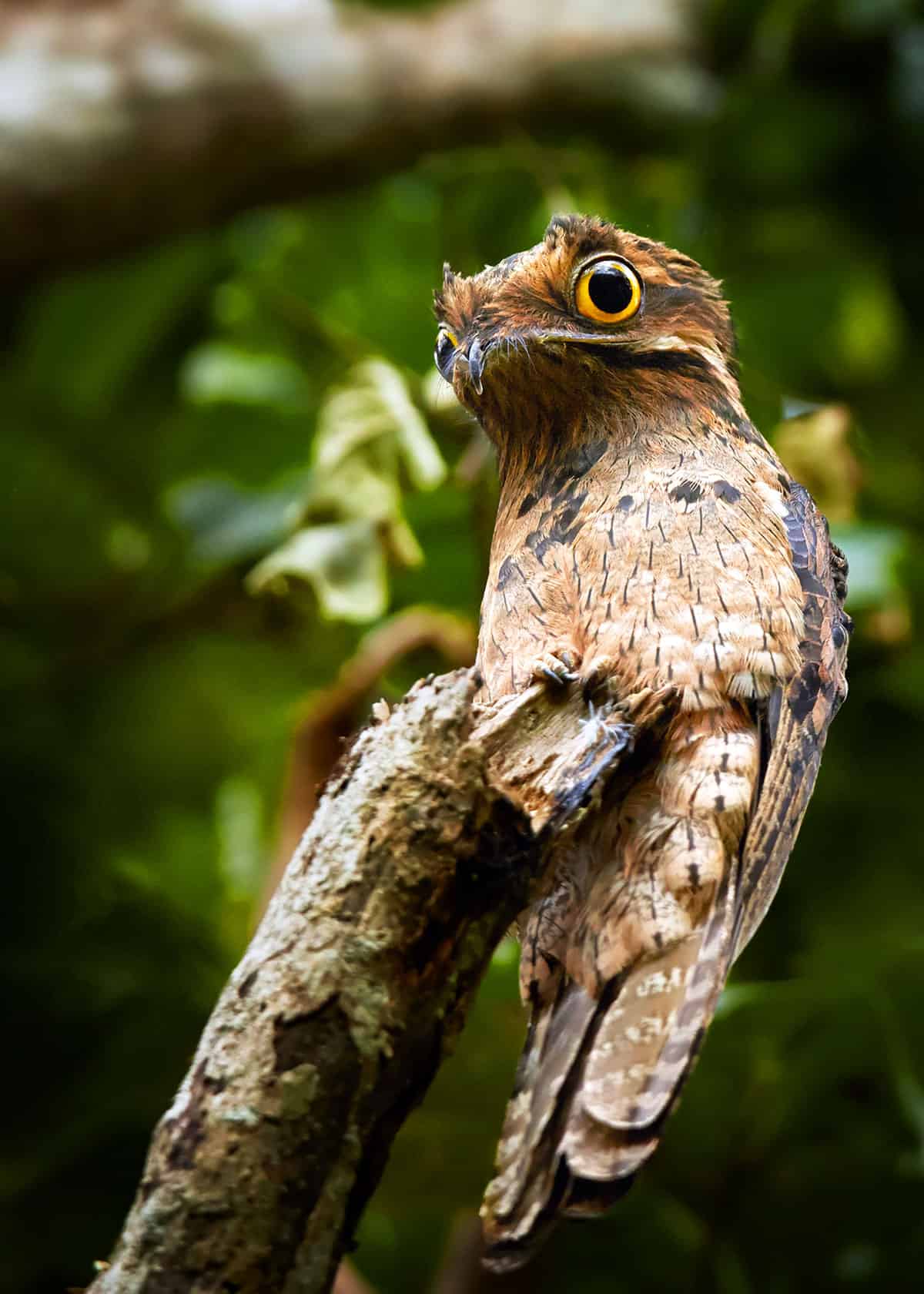
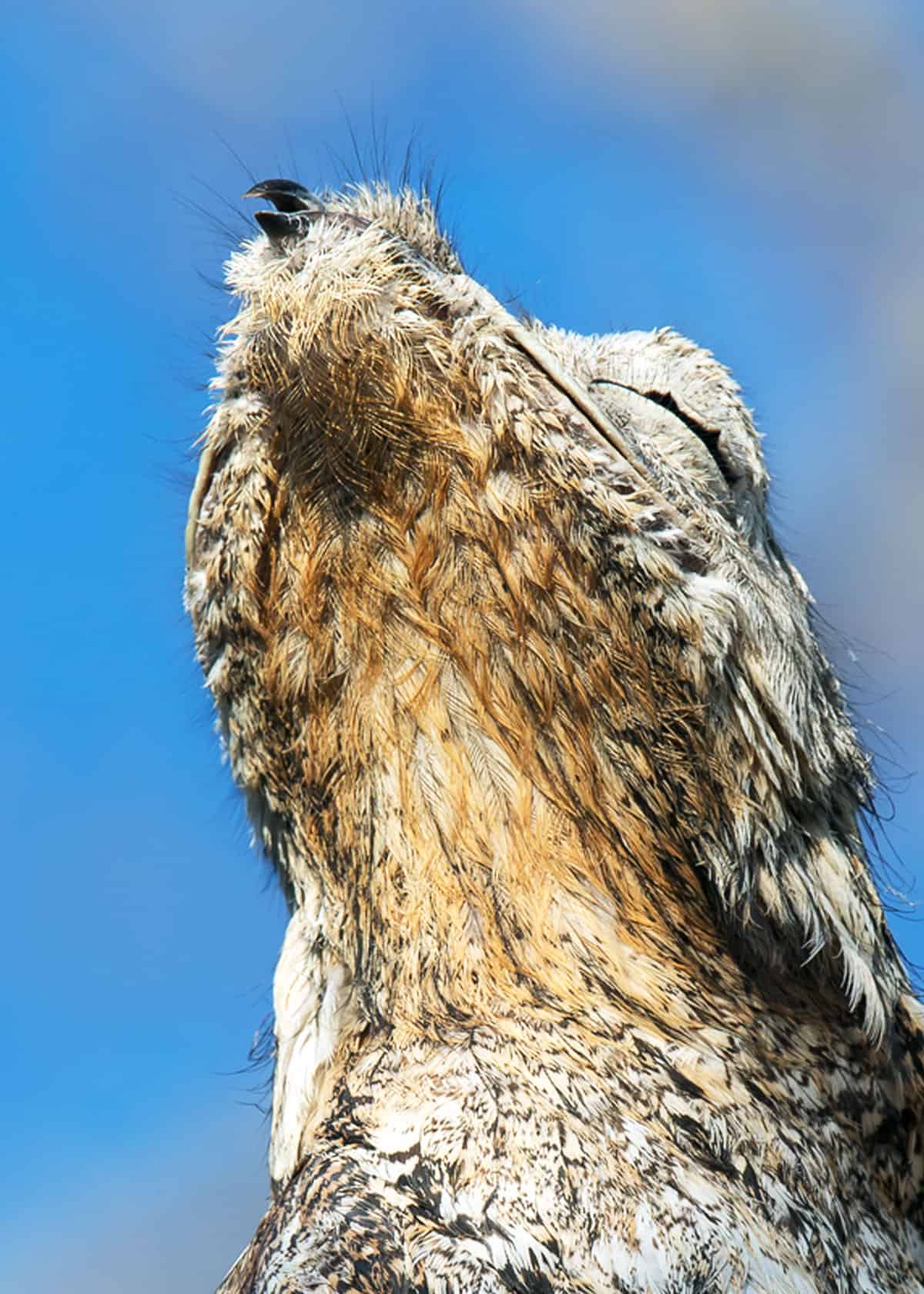
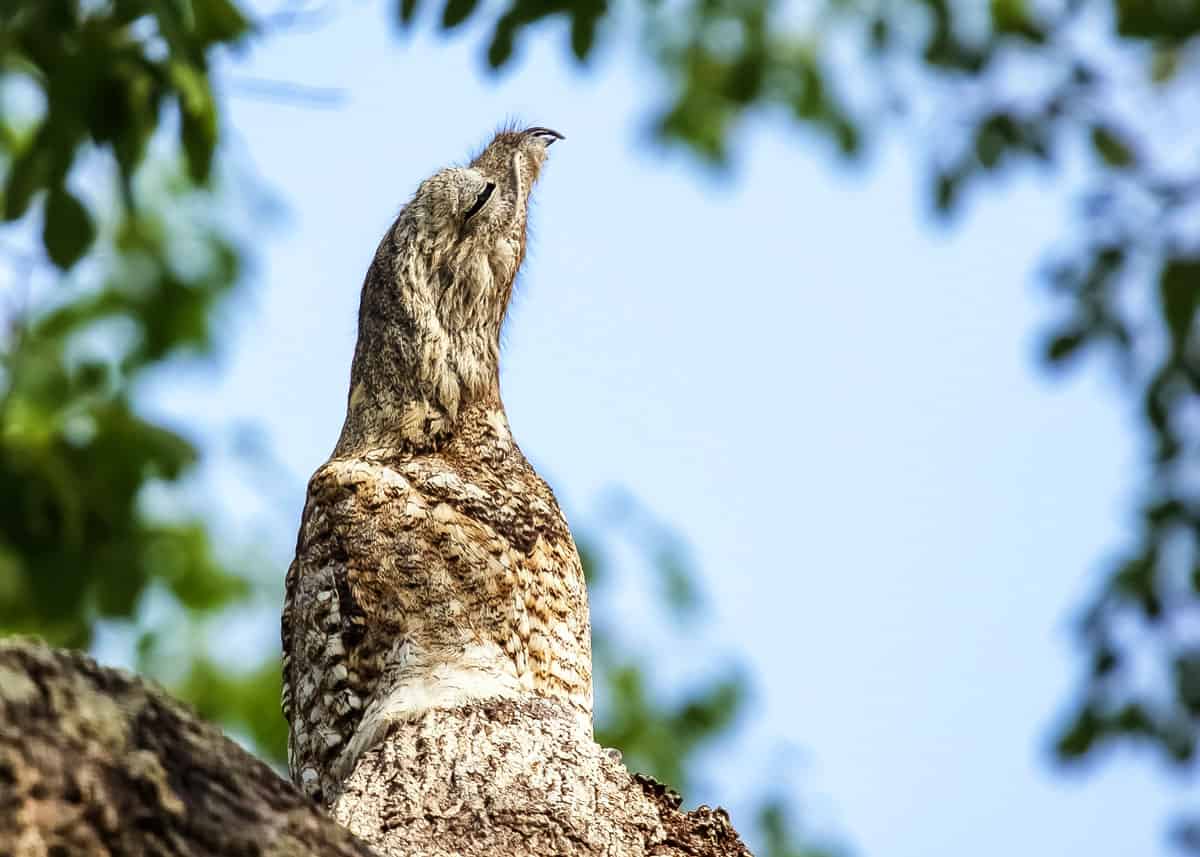
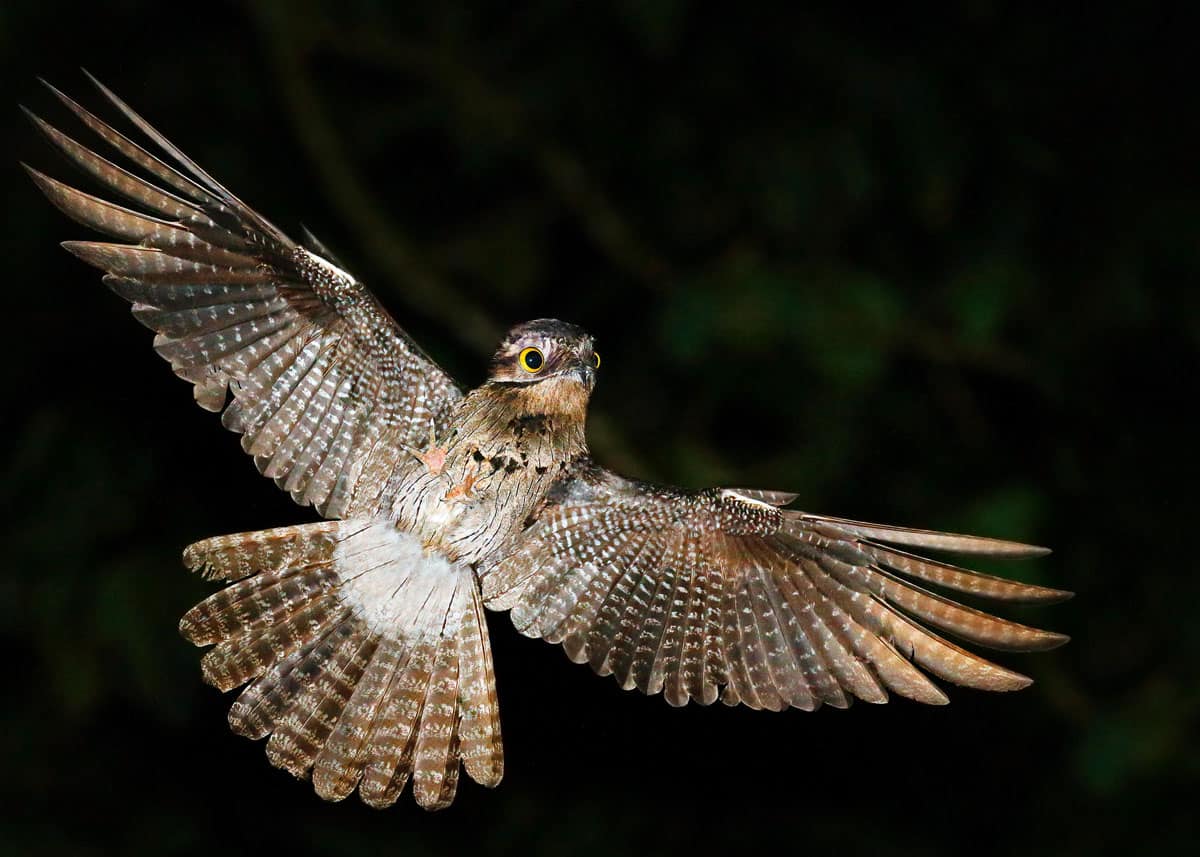
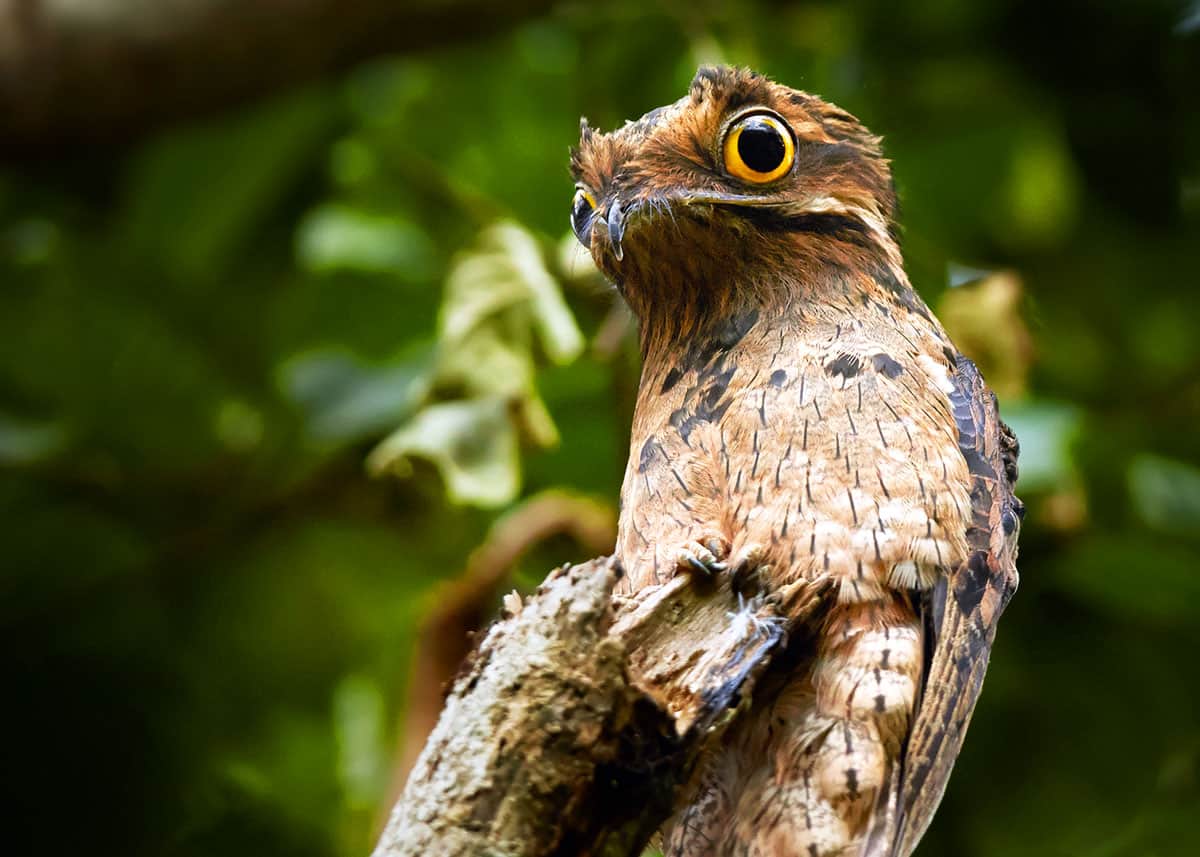
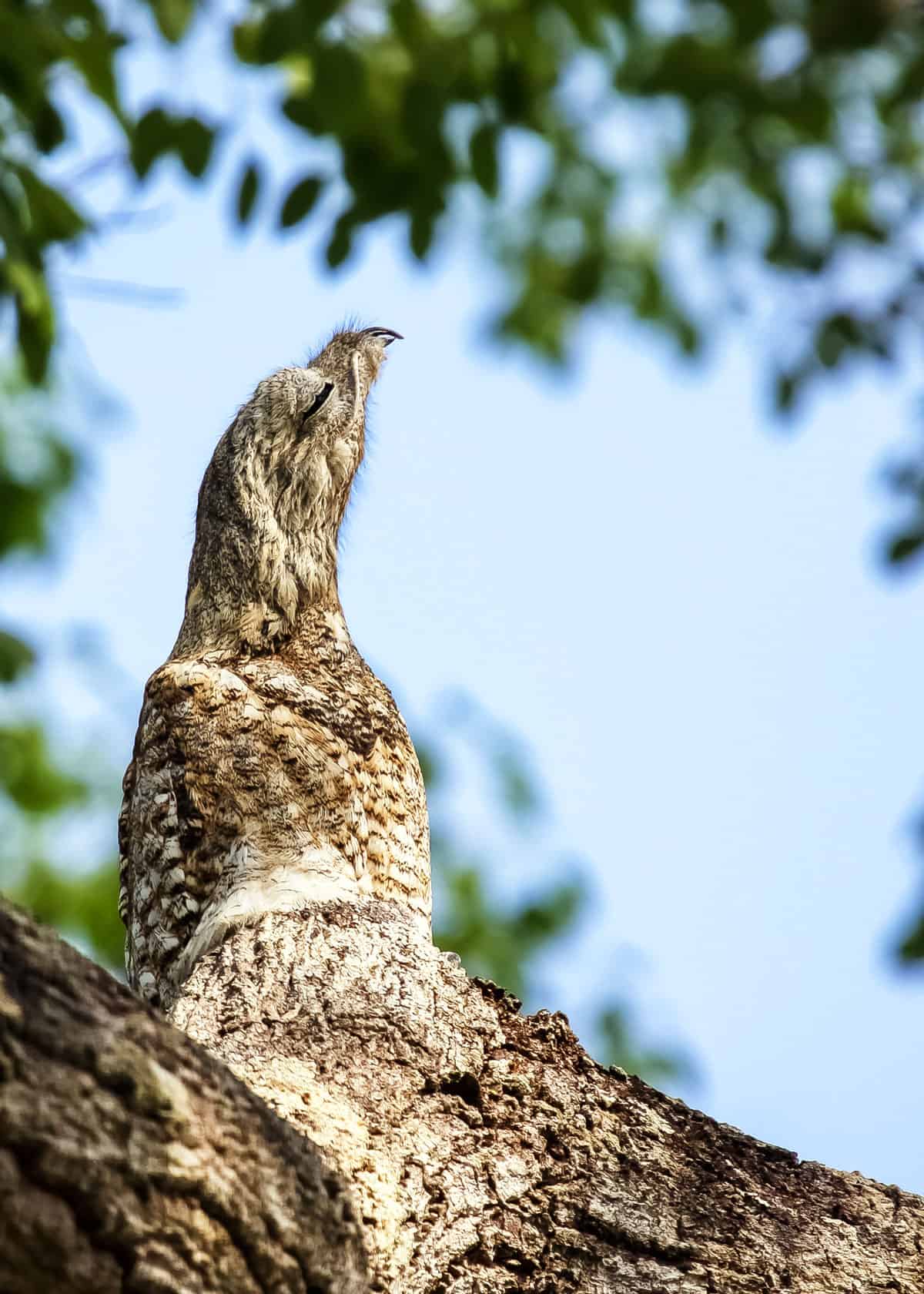

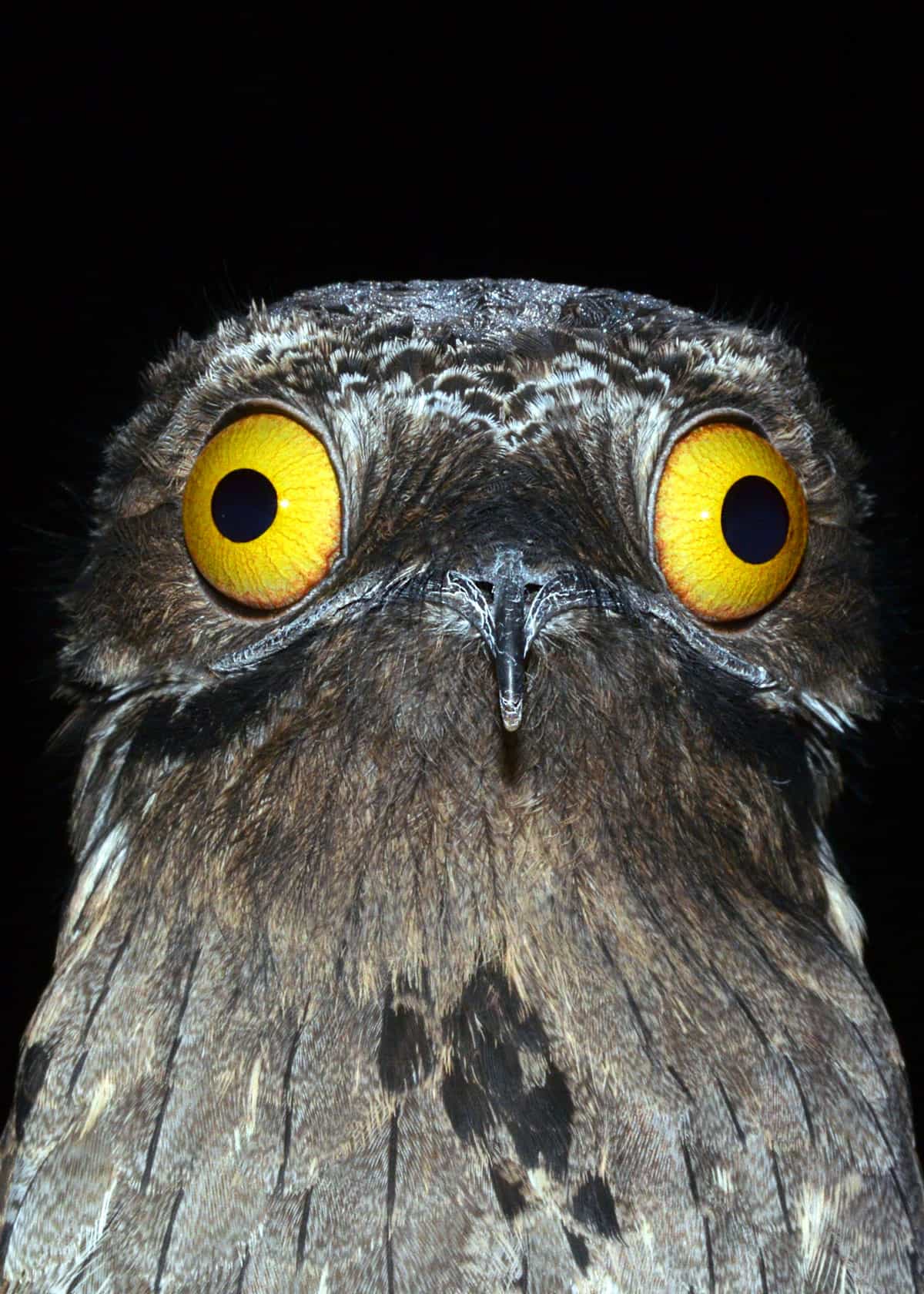
WynterEcho
Wednesday 26th of April 2023
These are interesting facts, thank you!
Rita Duffy
Sunday 20th of September 2020
These birds eat a lot of bad insects which make them valuable to humans. Keep diseases down.
Julian
Friday 24th of May 2019
Hey Drew, thanks for the article with these funny Potoo images and videos. Oneday I'll travel again to South America to spot one of these guys ;)
Regards from Berlin, Julian